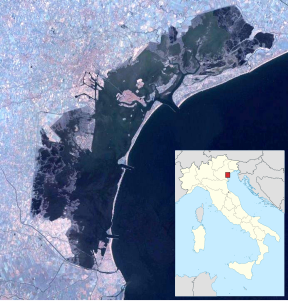La Salina
| La Salina | ||
|---|---|---|
| Waters | Venice lagoon | |
| Geographical location | 45 ° 30 '10.9 " N , 12 ° 27' 23.1" E | |
|
|
||
| surface | 5.345 6 ha | |
La Salina is an island in the north of the Venice lagoon . It has an area of about 0.053 km² or more precisely 53,456 m². It got its name when it was the center of sea salt extraction from 1844 to 1913 .
history
From the 5th to 9th centuries the island was part of Ammiana , a settlement that, according to legend, was founded by refugees from the Huns under the leadership of Attila , who was in Italy in 452.
A second wave of refugees in the 9th century caused the foundation of a Benedictine monastery . The church and monastery of San Felice e Fortunato date back to 889, when the monks of the Benedictine monastery of San Stefano fled Altinum from the Hungarians who sacked Veneto . The monastery became the burial place for several doges, including Orso II Particiaco in 932 .
From the 12th to the 14th centuries, the islands of Ammiana were gradually abandoned. The settlements of Costanziaca had a similar experience due to the deteriorating ecological and thus living conditions. In the middle of the 15th century, the last monks left the Monastery of San Felice e Fortunato and went to Venice. There they founded the monastery of San Filippo e Giacomo . The buildings left behind were robbed and destroyed, and the island remained uninhabited until the mid-19th century.
In 1844, La Salina, known at the time under the name Motta di San Felice, became the headquarters for a large-scale project to extract sea salt . During this work, the remains of the early medieval complex were found. The salt production facilities on La Salina were completed in 1857. Salt was extracted here until 1913.
Some families settled on the island after the salt extraction stopped and lived from horticulture and fishing. The cadastre from 1932 still records a large building with a courtyard, but it was no longer in use. Today two buildings, probably the corner towers, are still preserved. The last attempts at cultivation were given up in the mid-1950s.
From 1992 the island was prepared for agritourism , and there is also fishing.
Web links
- La Salina, website of the Comune di Venezia ( Memento of September 21, 2009 in the Internet Archive )
Remarks
- ↑ Venice Islands ( Memento of March 24, 2009 in the Internet Archive )
